Analyzing Microsoft's Organizational Structure, Culture, and Growth
VerifiedAdded on 2023/06/09
|11
|2426
|379
Case Study
AI Summary
This case study examines Microsoft's organizational structure and culture, focusing on the factors that influence its structure, the characteristics of its organizational design, and how the company manages the dynamic processes that shape its growth and evolution. It highlights Microsoft's product-type divisional organizational structure, emphasizing the impact of factors like organizational size, technology, and business strategies. The analysis identifies key characteristics such as product-type divisions, global corporate groups, and geographical segments. Furthermore, the study explores Microsoft's culture, leadership styles, and innovation strategies, illustrating how these elements contribute to the company's ability to adapt to a dynamic environment and achieve sustained growth. The report concludes that a supportive organizational structure, effective leadership, a culture of innovation, and a focus on customer satisfaction are critical for Microsoft's continued success.
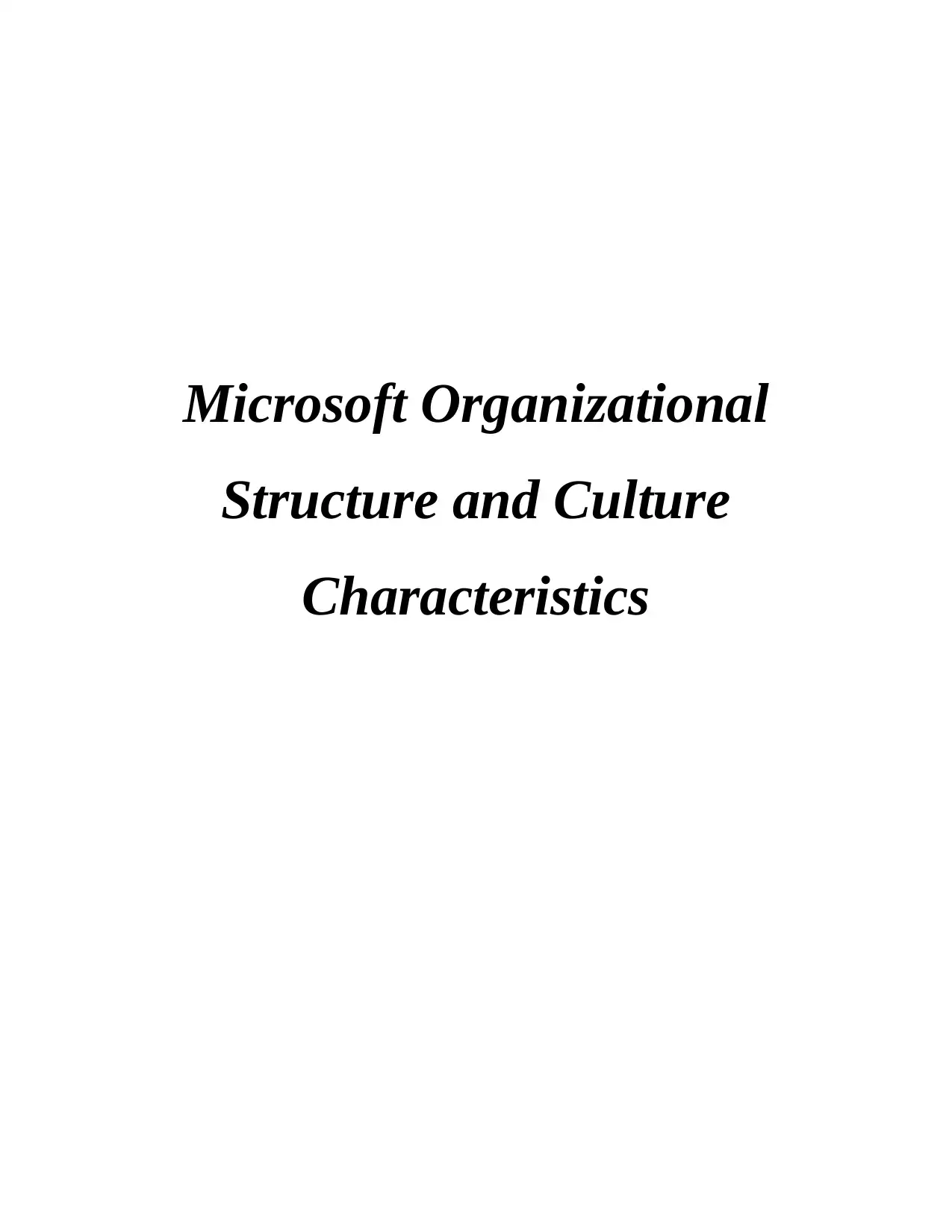
Microsoft Organizational
Structure and Culture
Characteristics
Structure and Culture
Characteristics
Secure Best Marks with AI Grader
Need help grading? Try our AI Grader for instant feedback on your assignments.
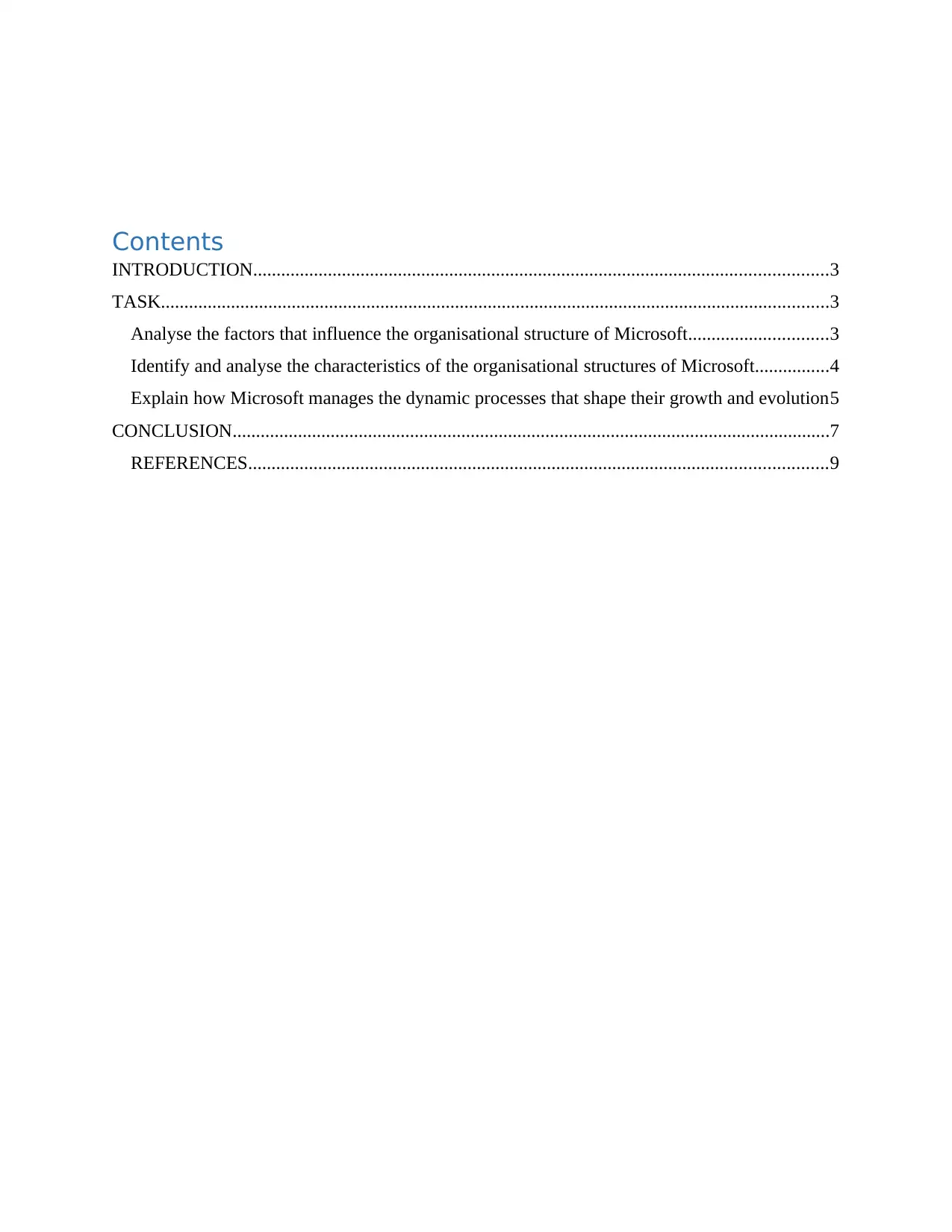
Contents
INTRODUCTION...........................................................................................................................3
TASK...............................................................................................................................................3
Analyse the factors that influence the organisational structure of Microsoft..............................3
Identify and analyse the characteristics of the organisational structures of Microsoft................4
Explain how Microsoft manages the dynamic processes that shape their growth and evolution5
CONCLUSION................................................................................................................................7
REFERENCES............................................................................................................................9
INTRODUCTION...........................................................................................................................3
TASK...............................................................................................................................................3
Analyse the factors that influence the organisational structure of Microsoft..............................3
Identify and analyse the characteristics of the organisational structures of Microsoft................4
Explain how Microsoft manages the dynamic processes that shape their growth and evolution5
CONCLUSION................................................................................................................................7
REFERENCES............................................................................................................................9
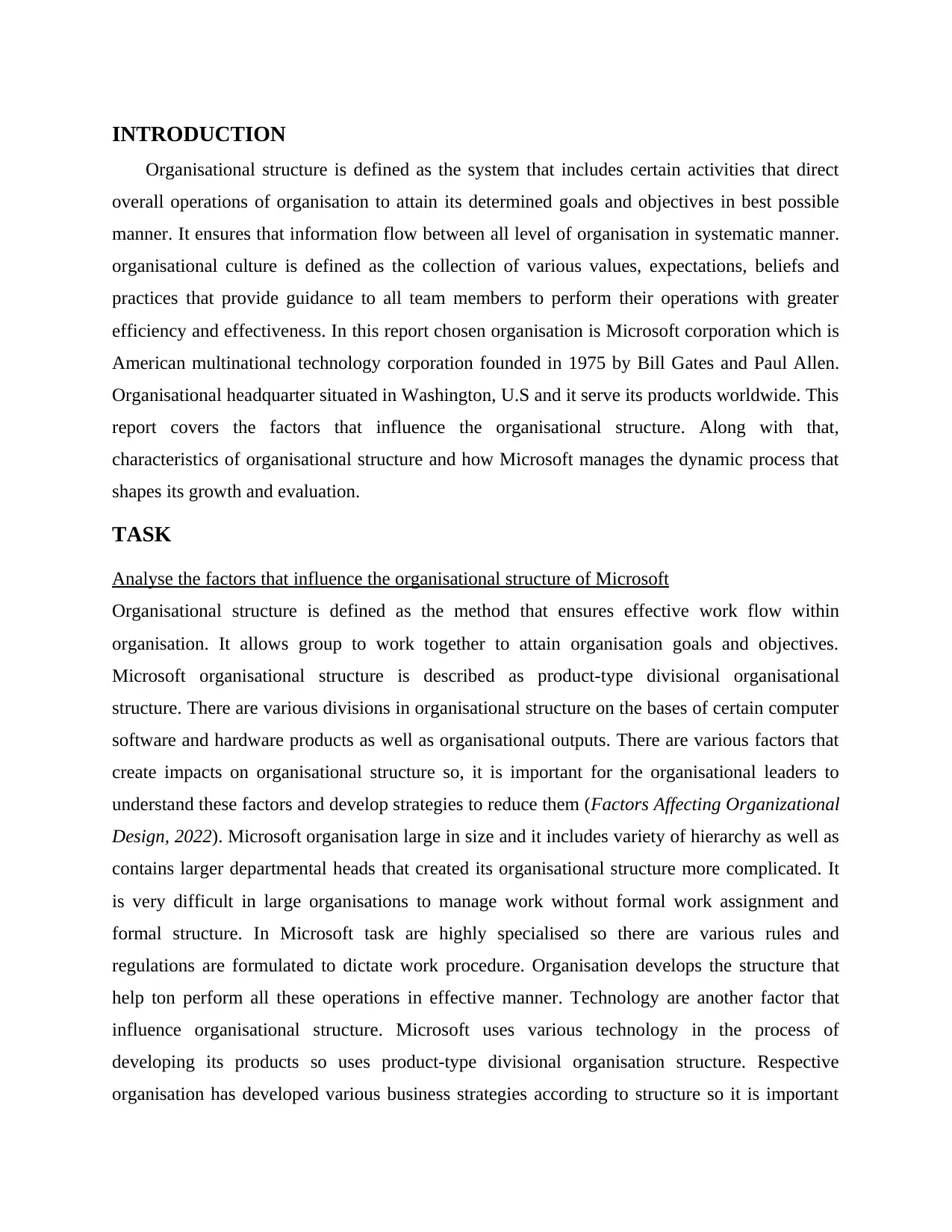
INTRODUCTION
Organisational structure is defined as the system that includes certain activities that direct
overall operations of organisation to attain its determined goals and objectives in best possible
manner. It ensures that information flow between all level of organisation in systematic manner.
organisational culture is defined as the collection of various values, expectations, beliefs and
practices that provide guidance to all team members to perform their operations with greater
efficiency and effectiveness. In this report chosen organisation is Microsoft corporation which is
American multinational technology corporation founded in 1975 by Bill Gates and Paul Allen.
Organisational headquarter situated in Washington, U.S and it serve its products worldwide. This
report covers the factors that influence the organisational structure. Along with that,
characteristics of organisational structure and how Microsoft manages the dynamic process that
shapes its growth and evaluation.
TASK
Analyse the factors that influence the organisational structure of Microsoft
Organisational structure is defined as the method that ensures effective work flow within
organisation. It allows group to work together to attain organisation goals and objectives.
Microsoft organisational structure is described as product-type divisional organisational
structure. There are various divisions in organisational structure on the bases of certain computer
software and hardware products as well as organisational outputs. There are various factors that
create impacts on organisational structure so, it is important for the organisational leaders to
understand these factors and develop strategies to reduce them (Factors Affecting Organizational
Design, 2022). Microsoft organisation large in size and it includes variety of hierarchy as well as
contains larger departmental heads that created its organisational structure more complicated. It
is very difficult in large organisations to manage work without formal work assignment and
formal structure. In Microsoft task are highly specialised so there are various rules and
regulations are formulated to dictate work procedure. Organisation develops the structure that
help ton perform all these operations in effective manner. Technology are another factor that
influence organisational structure. Microsoft uses various technology in the process of
developing its products so uses product-type divisional organisation structure. Respective
organisation has developed various business strategies according to structure so it is important
Organisational structure is defined as the system that includes certain activities that direct
overall operations of organisation to attain its determined goals and objectives in best possible
manner. It ensures that information flow between all level of organisation in systematic manner.
organisational culture is defined as the collection of various values, expectations, beliefs and
practices that provide guidance to all team members to perform their operations with greater
efficiency and effectiveness. In this report chosen organisation is Microsoft corporation which is
American multinational technology corporation founded in 1975 by Bill Gates and Paul Allen.
Organisational headquarter situated in Washington, U.S and it serve its products worldwide. This
report covers the factors that influence the organisational structure. Along with that,
characteristics of organisational structure and how Microsoft manages the dynamic process that
shapes its growth and evaluation.
TASK
Analyse the factors that influence the organisational structure of Microsoft
Organisational structure is defined as the method that ensures effective work flow within
organisation. It allows group to work together to attain organisation goals and objectives.
Microsoft organisational structure is described as product-type divisional organisational
structure. There are various divisions in organisational structure on the bases of certain computer
software and hardware products as well as organisational outputs. There are various factors that
create impacts on organisational structure so, it is important for the organisational leaders to
understand these factors and develop strategies to reduce them (Factors Affecting Organizational
Design, 2022). Microsoft organisation large in size and it includes variety of hierarchy as well as
contains larger departmental heads that created its organisational structure more complicated. It
is very difficult in large organisations to manage work without formal work assignment and
formal structure. In Microsoft task are highly specialised so there are various rules and
regulations are formulated to dictate work procedure. Organisation develops the structure that
help ton perform all these operations in effective manner. Technology are another factor that
influence organisational structure. Microsoft uses various technology in the process of
developing its products so uses product-type divisional organisation structure. Respective
organisation has developed various business strategies according to structure so it is important
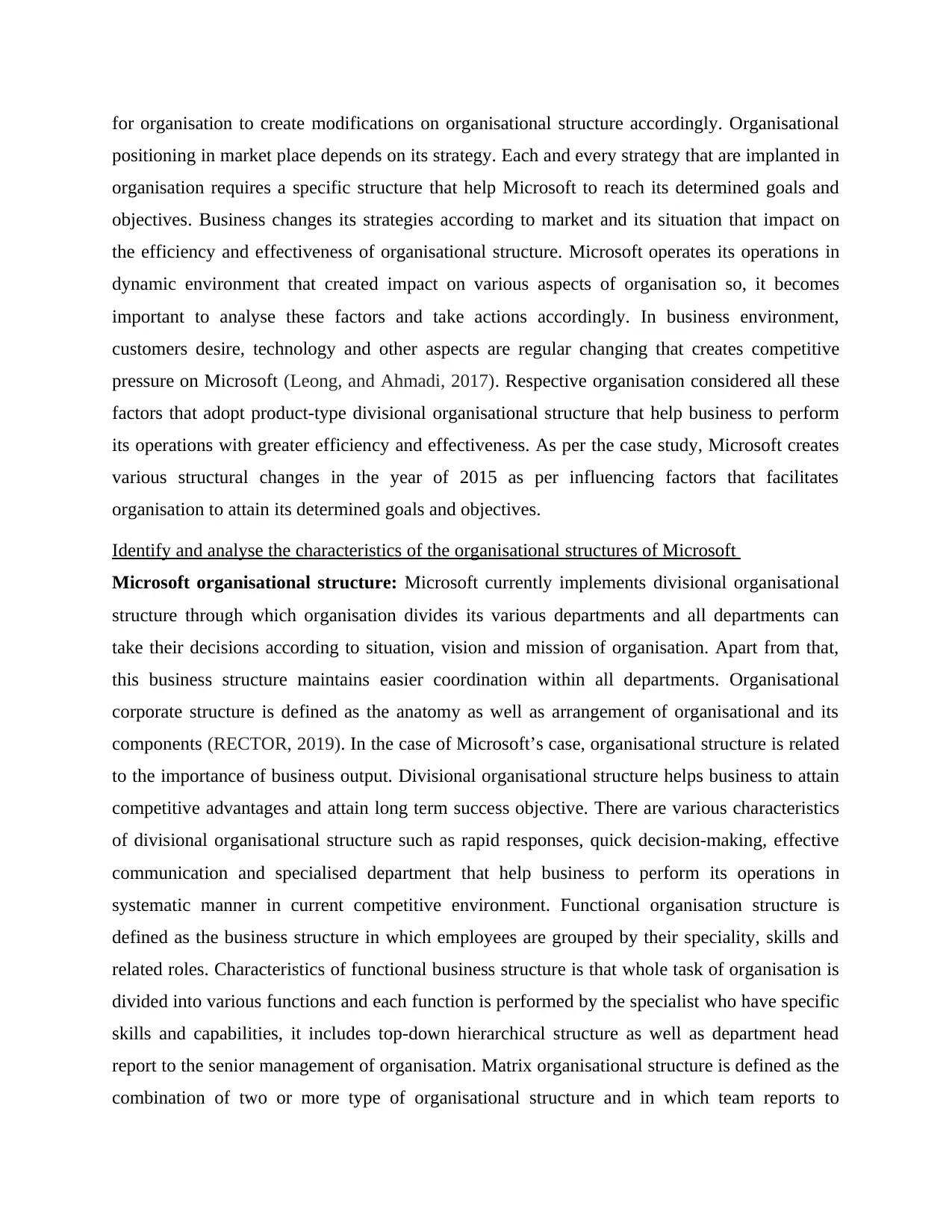
for organisation to create modifications on organisational structure accordingly. Organisational
positioning in market place depends on its strategy. Each and every strategy that are implanted in
organisation requires a specific structure that help Microsoft to reach its determined goals and
objectives. Business changes its strategies according to market and its situation that impact on
the efficiency and effectiveness of organisational structure. Microsoft operates its operations in
dynamic environment that created impact on various aspects of organisation so, it becomes
important to analyse these factors and take actions accordingly. In business environment,
customers desire, technology and other aspects are regular changing that creates competitive
pressure on Microsoft (Leong, and Ahmadi, 2017). Respective organisation considered all these
factors that adopt product-type divisional organisational structure that help business to perform
its operations with greater efficiency and effectiveness. As per the case study, Microsoft creates
various structural changes in the year of 2015 as per influencing factors that facilitates
organisation to attain its determined goals and objectives.
Identify and analyse the characteristics of the organisational structures of Microsoft
Microsoft organisational structure: Microsoft currently implements divisional organisational
structure through which organisation divides its various departments and all departments can
take their decisions according to situation, vision and mission of organisation. Apart from that,
this business structure maintains easier coordination within all departments. Organisational
corporate structure is defined as the anatomy as well as arrangement of organisational and its
components (RECTOR, 2019). In the case of Microsoft’s case, organisational structure is related
to the importance of business output. Divisional organisational structure helps business to attain
competitive advantages and attain long term success objective. There are various characteristics
of divisional organisational structure such as rapid responses, quick decision-making, effective
communication and specialised department that help business to perform its operations in
systematic manner in current competitive environment. Functional organisation structure is
defined as the business structure in which employees are grouped by their speciality, skills and
related roles. Characteristics of functional business structure is that whole task of organisation is
divided into various functions and each function is performed by the specialist who have specific
skills and capabilities, it includes top-down hierarchical structure as well as department head
report to the senior management of organisation. Matrix organisational structure is defined as the
combination of two or more type of organisational structure and in which team reports to
positioning in market place depends on its strategy. Each and every strategy that are implanted in
organisation requires a specific structure that help Microsoft to reach its determined goals and
objectives. Business changes its strategies according to market and its situation that impact on
the efficiency and effectiveness of organisational structure. Microsoft operates its operations in
dynamic environment that created impact on various aspects of organisation so, it becomes
important to analyse these factors and take actions accordingly. In business environment,
customers desire, technology and other aspects are regular changing that creates competitive
pressure on Microsoft (Leong, and Ahmadi, 2017). Respective organisation considered all these
factors that adopt product-type divisional organisational structure that help business to perform
its operations with greater efficiency and effectiveness. As per the case study, Microsoft creates
various structural changes in the year of 2015 as per influencing factors that facilitates
organisation to attain its determined goals and objectives.
Identify and analyse the characteristics of the organisational structures of Microsoft
Microsoft organisational structure: Microsoft currently implements divisional organisational
structure through which organisation divides its various departments and all departments can
take their decisions according to situation, vision and mission of organisation. Apart from that,
this business structure maintains easier coordination within all departments. Organisational
corporate structure is defined as the anatomy as well as arrangement of organisational and its
components (RECTOR, 2019). In the case of Microsoft’s case, organisational structure is related
to the importance of business output. Divisional organisational structure helps business to attain
competitive advantages and attain long term success objective. There are various characteristics
of divisional organisational structure such as rapid responses, quick decision-making, effective
communication and specialised department that help business to perform its operations in
systematic manner in current competitive environment. Functional organisation structure is
defined as the business structure in which employees are grouped by their speciality, skills and
related roles. Characteristics of functional business structure is that whole task of organisation is
divided into various functions and each function is performed by the specialist who have specific
skills and capabilities, it includes top-down hierarchical structure as well as department head
report to the senior management of organisation. Matrix organisational structure is defined as the
combination of two or more type of organisational structure and in which team reports to
Secure Best Marks with AI Grader
Need help grading? Try our AI Grader for instant feedback on your assignments.
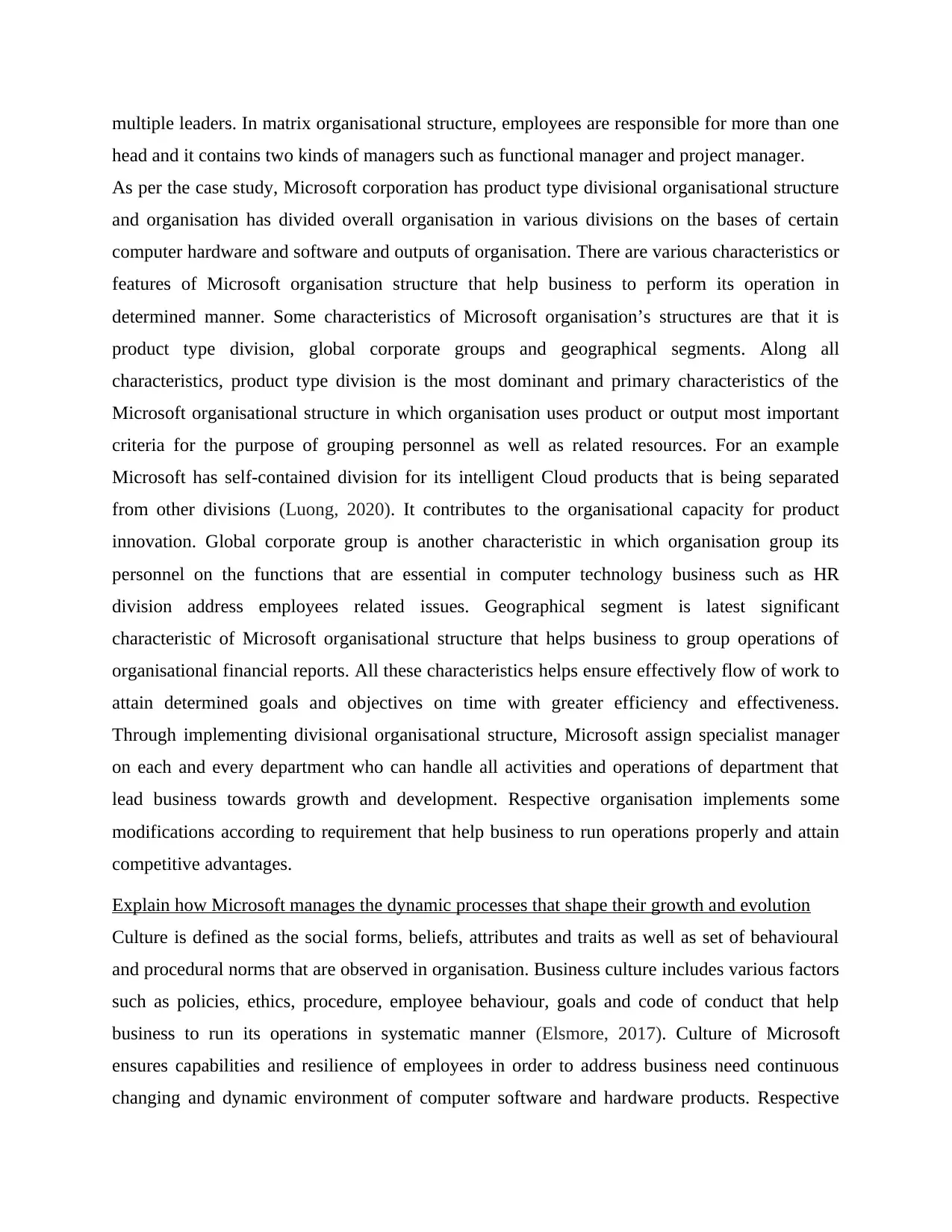
multiple leaders. In matrix organisational structure, employees are responsible for more than one
head and it contains two kinds of managers such as functional manager and project manager.
As per the case study, Microsoft corporation has product type divisional organisational structure
and organisation has divided overall organisation in various divisions on the bases of certain
computer hardware and software and outputs of organisation. There are various characteristics or
features of Microsoft organisation structure that help business to perform its operation in
determined manner. Some characteristics of Microsoft organisation’s structures are that it is
product type division, global corporate groups and geographical segments. Along all
characteristics, product type division is the most dominant and primary characteristics of the
Microsoft organisational structure in which organisation uses product or output most important
criteria for the purpose of grouping personnel as well as related resources. For an example
Microsoft has self-contained division for its intelligent Cloud products that is being separated
from other divisions (Luong, 2020). It contributes to the organisational capacity for product
innovation. Global corporate group is another characteristic in which organisation group its
personnel on the functions that are essential in computer technology business such as HR
division address employees related issues. Geographical segment is latest significant
characteristic of Microsoft organisational structure that helps business to group operations of
organisational financial reports. All these characteristics helps ensure effectively flow of work to
attain determined goals and objectives on time with greater efficiency and effectiveness.
Through implementing divisional organisational structure, Microsoft assign specialist manager
on each and every department who can handle all activities and operations of department that
lead business towards growth and development. Respective organisation implements some
modifications according to requirement that help business to run operations properly and attain
competitive advantages.
Explain how Microsoft manages the dynamic processes that shape their growth and evolution
Culture is defined as the social forms, beliefs, attributes and traits as well as set of behavioural
and procedural norms that are observed in organisation. Business culture includes various factors
such as policies, ethics, procedure, employee behaviour, goals and code of conduct that help
business to run its operations in systematic manner (Elsmore, 2017). Culture of Microsoft
ensures capabilities and resilience of employees in order to address business need continuous
changing and dynamic environment of computer software and hardware products. Respective
head and it contains two kinds of managers such as functional manager and project manager.
As per the case study, Microsoft corporation has product type divisional organisational structure
and organisation has divided overall organisation in various divisions on the bases of certain
computer hardware and software and outputs of organisation. There are various characteristics or
features of Microsoft organisation structure that help business to perform its operation in
determined manner. Some characteristics of Microsoft organisation’s structures are that it is
product type division, global corporate groups and geographical segments. Along all
characteristics, product type division is the most dominant and primary characteristics of the
Microsoft organisational structure in which organisation uses product or output most important
criteria for the purpose of grouping personnel as well as related resources. For an example
Microsoft has self-contained division for its intelligent Cloud products that is being separated
from other divisions (Luong, 2020). It contributes to the organisational capacity for product
innovation. Global corporate group is another characteristic in which organisation group its
personnel on the functions that are essential in computer technology business such as HR
division address employees related issues. Geographical segment is latest significant
characteristic of Microsoft organisational structure that helps business to group operations of
organisational financial reports. All these characteristics helps ensure effectively flow of work to
attain determined goals and objectives on time with greater efficiency and effectiveness.
Through implementing divisional organisational structure, Microsoft assign specialist manager
on each and every department who can handle all activities and operations of department that
lead business towards growth and development. Respective organisation implements some
modifications according to requirement that help business to run operations properly and attain
competitive advantages.
Explain how Microsoft manages the dynamic processes that shape their growth and evolution
Culture is defined as the social forms, beliefs, attributes and traits as well as set of behavioural
and procedural norms that are observed in organisation. Business culture includes various factors
such as policies, ethics, procedure, employee behaviour, goals and code of conduct that help
business to run its operations in systematic manner (Elsmore, 2017). Culture of Microsoft
ensures capabilities and resilience of employees in order to address business need continuous
changing and dynamic environment of computer software and hardware products. Respective
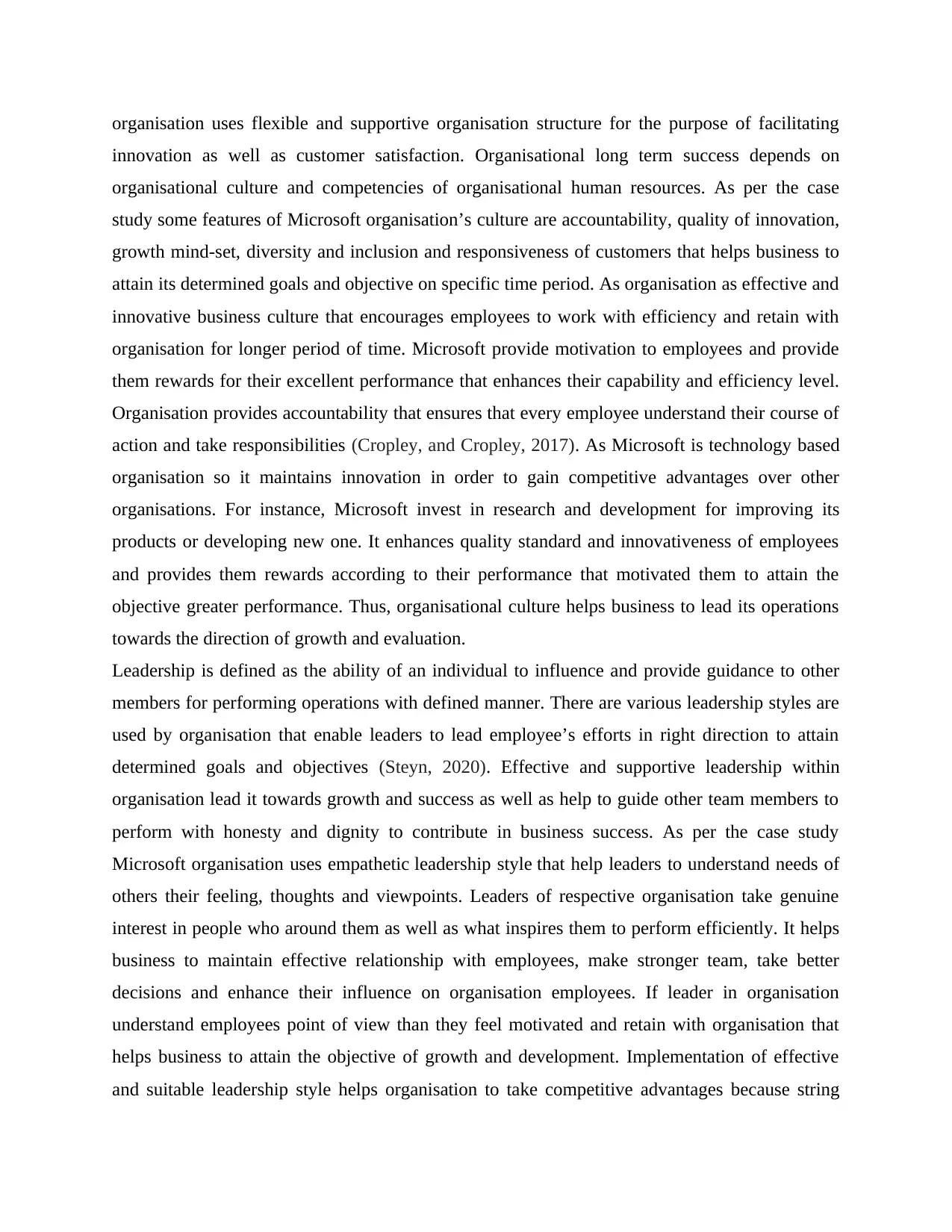
organisation uses flexible and supportive organisation structure for the purpose of facilitating
innovation as well as customer satisfaction. Organisational long term success depends on
organisational culture and competencies of organisational human resources. As per the case
study some features of Microsoft organisation’s culture are accountability, quality of innovation,
growth mind-set, diversity and inclusion and responsiveness of customers that helps business to
attain its determined goals and objective on specific time period. As organisation as effective and
innovative business culture that encourages employees to work with efficiency and retain with
organisation for longer period of time. Microsoft provide motivation to employees and provide
them rewards for their excellent performance that enhances their capability and efficiency level.
Organisation provides accountability that ensures that every employee understand their course of
action and take responsibilities (Cropley, and Cropley, 2017). As Microsoft is technology based
organisation so it maintains innovation in order to gain competitive advantages over other
organisations. For instance, Microsoft invest in research and development for improving its
products or developing new one. It enhances quality standard and innovativeness of employees
and provides them rewards according to their performance that motivated them to attain the
objective greater performance. Thus, organisational culture helps business to lead its operations
towards the direction of growth and evaluation.
Leadership is defined as the ability of an individual to influence and provide guidance to other
members for performing operations with defined manner. There are various leadership styles are
used by organisation that enable leaders to lead employee’s efforts in right direction to attain
determined goals and objectives (Steyn, 2020). Effective and supportive leadership within
organisation lead it towards growth and success as well as help to guide other team members to
perform with honesty and dignity to contribute in business success. As per the case study
Microsoft organisation uses empathetic leadership style that help leaders to understand needs of
others their feeling, thoughts and viewpoints. Leaders of respective organisation take genuine
interest in people who around them as well as what inspires them to perform efficiently. It helps
business to maintain effective relationship with employees, make stronger team, take better
decisions and enhance their influence on organisation employees. If leader in organisation
understand employees point of view than they feel motivated and retain with organisation that
helps business to attain the objective of growth and development. Implementation of effective
and suitable leadership style helps organisation to take competitive advantages because string
innovation as well as customer satisfaction. Organisational long term success depends on
organisational culture and competencies of organisational human resources. As per the case
study some features of Microsoft organisation’s culture are accountability, quality of innovation,
growth mind-set, diversity and inclusion and responsiveness of customers that helps business to
attain its determined goals and objective on specific time period. As organisation as effective and
innovative business culture that encourages employees to work with efficiency and retain with
organisation for longer period of time. Microsoft provide motivation to employees and provide
them rewards for their excellent performance that enhances their capability and efficiency level.
Organisation provides accountability that ensures that every employee understand their course of
action and take responsibilities (Cropley, and Cropley, 2017). As Microsoft is technology based
organisation so it maintains innovation in order to gain competitive advantages over other
organisations. For instance, Microsoft invest in research and development for improving its
products or developing new one. It enhances quality standard and innovativeness of employees
and provides them rewards according to their performance that motivated them to attain the
objective greater performance. Thus, organisational culture helps business to lead its operations
towards the direction of growth and evaluation.
Leadership is defined as the ability of an individual to influence and provide guidance to other
members for performing operations with defined manner. There are various leadership styles are
used by organisation that enable leaders to lead employee’s efforts in right direction to attain
determined goals and objectives (Steyn, 2020). Effective and supportive leadership within
organisation lead it towards growth and success as well as help to guide other team members to
perform with honesty and dignity to contribute in business success. As per the case study
Microsoft organisation uses empathetic leadership style that help leaders to understand needs of
others their feeling, thoughts and viewpoints. Leaders of respective organisation take genuine
interest in people who around them as well as what inspires them to perform efficiently. It helps
business to maintain effective relationship with employees, make stronger team, take better
decisions and enhance their influence on organisation employees. If leader in organisation
understand employees point of view than they feel motivated and retain with organisation that
helps business to attain the objective of growth and development. Implementation of effective
and suitable leadership style helps organisation to take competitive advantages because string
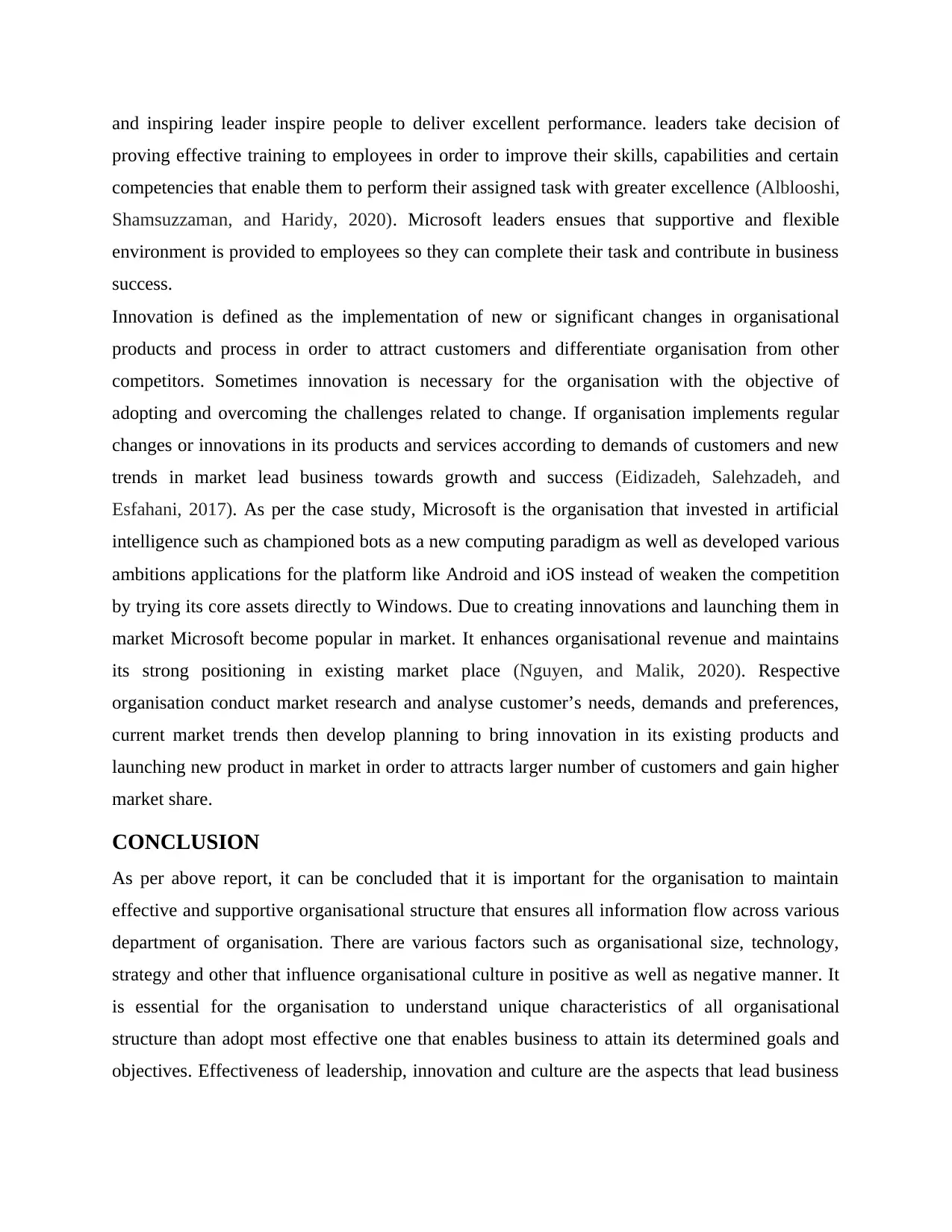
and inspiring leader inspire people to deliver excellent performance. leaders take decision of
proving effective training to employees in order to improve their skills, capabilities and certain
competencies that enable them to perform their assigned task with greater excellence (Alblooshi,
Shamsuzzaman, and Haridy, 2020). Microsoft leaders ensues that supportive and flexible
environment is provided to employees so they can complete their task and contribute in business
success.
Innovation is defined as the implementation of new or significant changes in organisational
products and process in order to attract customers and differentiate organisation from other
competitors. Sometimes innovation is necessary for the organisation with the objective of
adopting and overcoming the challenges related to change. If organisation implements regular
changes or innovations in its products and services according to demands of customers and new
trends in market lead business towards growth and success (Eidizadeh, Salehzadeh, and
Esfahani, 2017). As per the case study, Microsoft is the organisation that invested in artificial
intelligence such as championed bots as a new computing paradigm as well as developed various
ambitions applications for the platform like Android and iOS instead of weaken the competition
by trying its core assets directly to Windows. Due to creating innovations and launching them in
market Microsoft become popular in market. It enhances organisational revenue and maintains
its strong positioning in existing market place (Nguyen, and Malik, 2020). Respective
organisation conduct market research and analyse customer’s needs, demands and preferences,
current market trends then develop planning to bring innovation in its existing products and
launching new product in market in order to attracts larger number of customers and gain higher
market share.
CONCLUSION
As per above report, it can be concluded that it is important for the organisation to maintain
effective and supportive organisational structure that ensures all information flow across various
department of organisation. There are various factors such as organisational size, technology,
strategy and other that influence organisational culture in positive as well as negative manner. It
is essential for the organisation to understand unique characteristics of all organisational
structure than adopt most effective one that enables business to attain its determined goals and
objectives. Effectiveness of leadership, innovation and culture are the aspects that lead business
proving effective training to employees in order to improve their skills, capabilities and certain
competencies that enable them to perform their assigned task with greater excellence (Alblooshi,
Shamsuzzaman, and Haridy, 2020). Microsoft leaders ensues that supportive and flexible
environment is provided to employees so they can complete their task and contribute in business
success.
Innovation is defined as the implementation of new or significant changes in organisational
products and process in order to attract customers and differentiate organisation from other
competitors. Sometimes innovation is necessary for the organisation with the objective of
adopting and overcoming the challenges related to change. If organisation implements regular
changes or innovations in its products and services according to demands of customers and new
trends in market lead business towards growth and success (Eidizadeh, Salehzadeh, and
Esfahani, 2017). As per the case study, Microsoft is the organisation that invested in artificial
intelligence such as championed bots as a new computing paradigm as well as developed various
ambitions applications for the platform like Android and iOS instead of weaken the competition
by trying its core assets directly to Windows. Due to creating innovations and launching them in
market Microsoft become popular in market. It enhances organisational revenue and maintains
its strong positioning in existing market place (Nguyen, and Malik, 2020). Respective
organisation conduct market research and analyse customer’s needs, demands and preferences,
current market trends then develop planning to bring innovation in its existing products and
launching new product in market in order to attracts larger number of customers and gain higher
market share.
CONCLUSION
As per above report, it can be concluded that it is important for the organisation to maintain
effective and supportive organisational structure that ensures all information flow across various
department of organisation. There are various factors such as organisational size, technology,
strategy and other that influence organisational culture in positive as well as negative manner. It
is essential for the organisation to understand unique characteristics of all organisational
structure than adopt most effective one that enables business to attain its determined goals and
objectives. Effectiveness of leadership, innovation and culture are the aspects that lead business
Paraphrase This Document
Need a fresh take? Get an instant paraphrase of this document with our AI Paraphraser

towards growth and evaluation so, business should implement them as organisational goals and
objectives.
objectives.
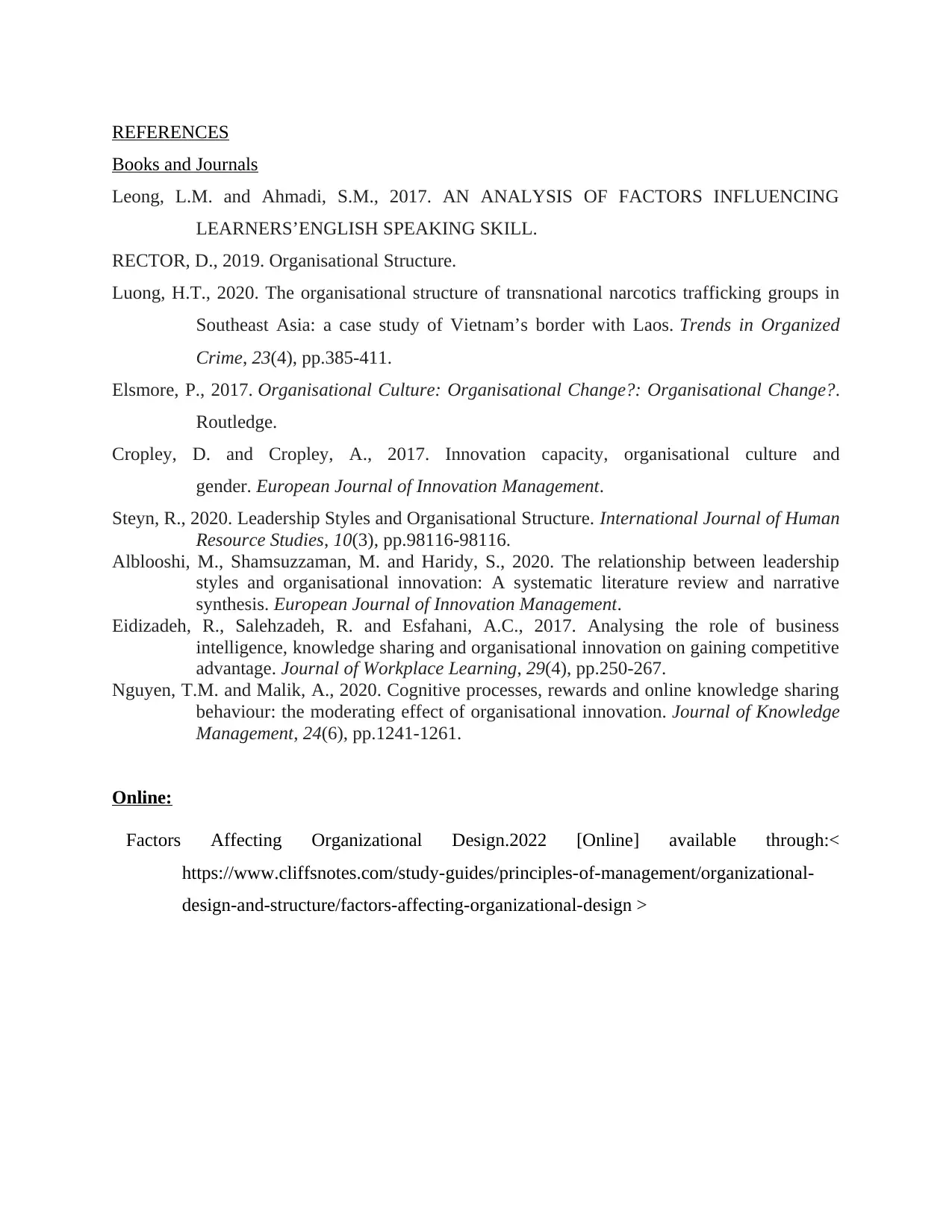
REFERENCES
Books and Journals
Leong, L.M. and Ahmadi, S.M., 2017. AN ANALYSIS OF FACTORS INFLUENCING
LEARNERS’ENGLISH SPEAKING SKILL.
RECTOR, D., 2019. Organisational Structure.
Luong, H.T., 2020. The organisational structure of transnational narcotics trafficking groups in
Southeast Asia: a case study of Vietnam’s border with Laos. Trends in Organized
Crime, 23(4), pp.385-411.
Elsmore, P., 2017. Organisational Culture: Organisational Change?: Organisational Change?.
Routledge.
Cropley, D. and Cropley, A., 2017. Innovation capacity, organisational culture and
gender. European Journal of Innovation Management.
Steyn, R., 2020. Leadership Styles and Organisational Structure. International Journal of Human
Resource Studies, 10(3), pp.98116-98116.
Alblooshi, M., Shamsuzzaman, M. and Haridy, S., 2020. The relationship between leadership
styles and organisational innovation: A systematic literature review and narrative
synthesis. European Journal of Innovation Management.
Eidizadeh, R., Salehzadeh, R. and Esfahani, A.C., 2017. Analysing the role of business
intelligence, knowledge sharing and organisational innovation on gaining competitive
advantage. Journal of Workplace Learning, 29(4), pp.250-267.
Nguyen, T.M. and Malik, A., 2020. Cognitive processes, rewards and online knowledge sharing
behaviour: the moderating effect of organisational innovation. Journal of Knowledge
Management, 24(6), pp.1241-1261.
Online:
Factors Affecting Organizational Design.2022 [Online] available through:<
https://www.cliffsnotes.com/study-guides/principles-of-management/organizational-
design-and-structure/factors-affecting-organizational-design >
Books and Journals
Leong, L.M. and Ahmadi, S.M., 2017. AN ANALYSIS OF FACTORS INFLUENCING
LEARNERS’ENGLISH SPEAKING SKILL.
RECTOR, D., 2019. Organisational Structure.
Luong, H.T., 2020. The organisational structure of transnational narcotics trafficking groups in
Southeast Asia: a case study of Vietnam’s border with Laos. Trends in Organized
Crime, 23(4), pp.385-411.
Elsmore, P., 2017. Organisational Culture: Organisational Change?: Organisational Change?.
Routledge.
Cropley, D. and Cropley, A., 2017. Innovation capacity, organisational culture and
gender. European Journal of Innovation Management.
Steyn, R., 2020. Leadership Styles and Organisational Structure. International Journal of Human
Resource Studies, 10(3), pp.98116-98116.
Alblooshi, M., Shamsuzzaman, M. and Haridy, S., 2020. The relationship between leadership
styles and organisational innovation: A systematic literature review and narrative
synthesis. European Journal of Innovation Management.
Eidizadeh, R., Salehzadeh, R. and Esfahani, A.C., 2017. Analysing the role of business
intelligence, knowledge sharing and organisational innovation on gaining competitive
advantage. Journal of Workplace Learning, 29(4), pp.250-267.
Nguyen, T.M. and Malik, A., 2020. Cognitive processes, rewards and online knowledge sharing
behaviour: the moderating effect of organisational innovation. Journal of Knowledge
Management, 24(6), pp.1241-1261.
Online:
Factors Affecting Organizational Design.2022 [Online] available through:<
https://www.cliffsnotes.com/study-guides/principles-of-management/organizational-
design-and-structure/factors-affecting-organizational-design >

Secure Best Marks with AI Grader
Need help grading? Try our AI Grader for instant feedback on your assignments.

1 out of 11
Related Documents
Your All-in-One AI-Powered Toolkit for Academic Success.
+13062052269
info@desklib.com
Available 24*7 on WhatsApp / Email
![[object Object]](/_next/static/media/star-bottom.7253800d.svg)
Unlock your academic potential
© 2024 | Zucol Services PVT LTD | All rights reserved.



